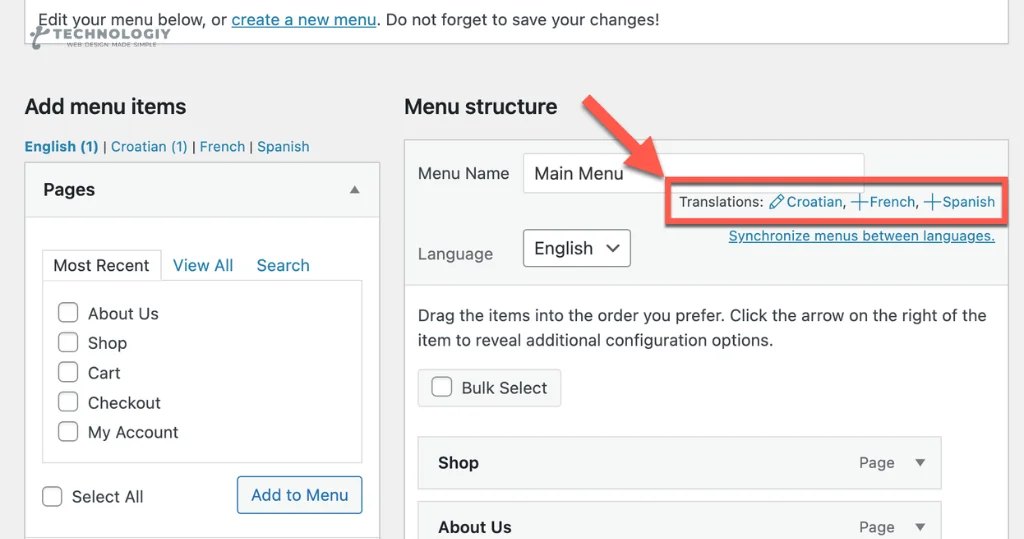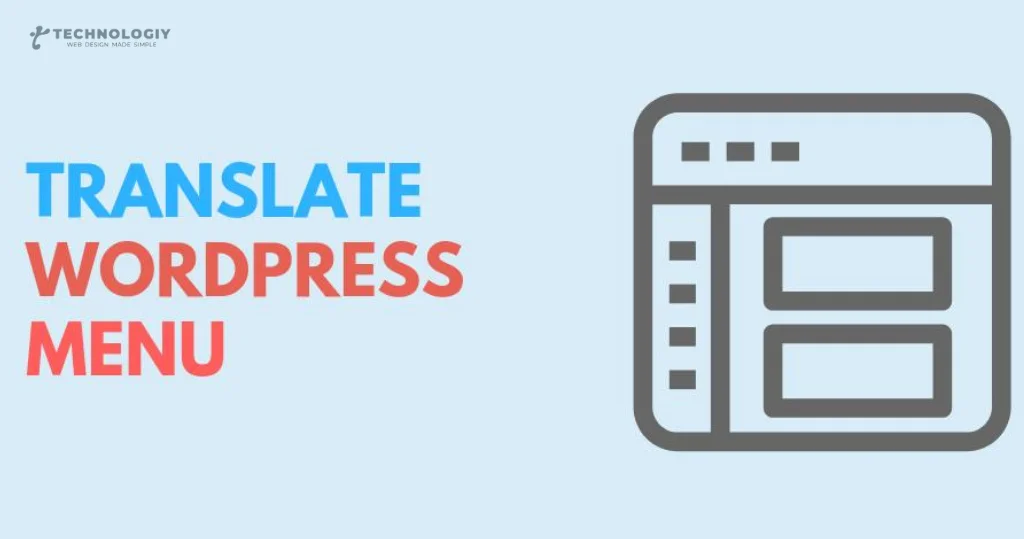Translate WordPress Menus: The Ultimate Step-by-Step Tutorial: When it comes to creating a multilingual website using WordPress, one crucial aspect that often gets overlooked is translating the menus. Having translate WordPress menus menus is essential to ensure a seamless user experience for your global audience. In this comprehensive guide, we will walk you through the process of translating WordPress menus, step-by-step. Whether you are a beginner or an experienced WordPress user, this tutorial will provide you with all the information you need to successfully translate WordPress menus.
Step 1: Install a Translation Plugin:
The first step is to install a translation plugin that is compatible with WordPress. There are several options available, but one of the most popular and user-friendly plugins is WPML (WordPress Multilingual Plugin). Install and activate the plugin from the WordPress dashboard.
Step 2: Configure the Translation Settings:
Once the plugin is activated, you need to configure the translation settings. Go to the plugin settings page and select the languages you want to translate WordPress menus into. WPML allows you to choose from a wide range of languages, making it suitable for any global audience.
Step 3: Create Menu Locations:
Before you start translating your menus, you need to create menu locations for each language. Go to the WordPress customizer and create a new menu for each language. Assign a location to each menu so that WordPress knows where to display them on your website.
Step 4: Translate WordPress Menus Items:
Now it’s time to translate WordPress menu items. To do this, go to the Appearance > Menus page in your WordPress dashboard. Select the menu you want to translate and click on the language switcher provided by the translation plugin. This will enable you to switch between the different languages and translate the menu items accordingly.
Step 5: Set Language Switcher:
To allow users to switch between different languages, you need to add a language switcher to your website. Most translation plugins, including WPML, provide a language switcher widget that you can easily add to your menus or sidebar. Configure the language switcher settings according to your preferences and place it in a prominent location on your website.
Step 6: Test and Optimize:
Once you have translated your menus and set up the language switcher, it’s time to test everything. Visit your website as a user and make sure the translate WordPress menus are displaying correctly. Test the language switcher and ensure it is working as expected. If you encounter any issues, go back to the plugin settings and make the necessary adjustments.
Translating WordPress menus is an essential step in creating a multilingual website that caters to a global audience. With the help of a translation plugin like WPML, you can easily translate WordPress menus and provide a seamless user experience in multiple languages. Follow the step-by-step tutorial outlined in this guide, and you’ll have your translate WordPress menus in no time.
Remember, creating a multilingual website requires attention to detail and continuous optimization. Keep an eye on user feedback and make any necessary adjustments to ensure a smooth user experience across all languages. Start translating your WordPress menus today and unlock the full potential of your website for a global audience.Translate WordPress Menus:
A Comprehensive Guide for BeginnersAre you a WordPress user looking to reach a wider audience with your website? One effective way to do so is by translating your menus. By providing translate WordPress menus menu options, you can cater to a diverse range of visitors and enhance their browsing experience. In this comprehensive guide, we will walk you through the process of translating WordPress menus, step by step.

Why Translate WordPress Menus?
As the internet connects people from all corners of the globe, it’s essential to ensure that your website is accessible and user-friendly for a global audience. Translating your menus helps break down language barriers, allowing visitors to navigate your site effortlessly and find the information they need.
Translating WordPress menus also opens up new opportunities for your website. By catering to different language speakers, you increase the chances of attracting international visitors, expanding your reach, and potentially boosting your online presence.
Getting Started: Choosing the Right Translation Plugin:
To begin translating your WordPress menus, you’ll need a reliable translation plugin. There are several options available, but we recommend the popular and user-friendly WPML (WordPress Multilingual Plugin). WPML makes the translation process seamless and convenient, even for beginners.
Installing and Activating WPML:
Once you’ve chosen WPML as your translation plugin, follow these steps to install and activate it.
- Log in to your WordPress admin dashboard.
- Navigate to the “Plugins” section and click on “Add New.”
- Search for “WPML” in the search bar.
- Click on “Install Now” next to the WPML plugin.
- After installation, click on “Activate” to activate the plugin.
Setting Up WPML:
After activation, you’ll need to configure WPML to suit your website’s needs. Follow these steps to set up WPML:
- Click on the “WPML” menu item in your WordPress admin dashboard.
- Select your preferred language for the website.
- Choose the translation options that best fit your needs.
- Configure the language switcher for your menus.
- Save your settings.
Translating Your WordPress Menus:
Now that WPML is set up, it’s time to start translating your menus. Here’s a step-by-step guide:
- Navigate to “WPML” in your WordPress admin dashboard.
- Click on “String Translation.”
- Look for your menu items under the “Texts in the theme and plugins” section.
- Select the menu item you want to translate.
- Enter the translated text in the provided field.
- Save your changes.
Repeat these steps for each menu item you wish to translate. Make sure to save your changes after translating each item to ensure all modifications are applied.
Testing and Verifying Translations:
After translating your menus, it’s crucial to test and verify the translations to ensure they display correctly on your website. Here’s how:
- Visit your website as a visitor.
- Change the language using the language switcher.
- Navigate through your menus to check if the translations are accurate and properly displayed.
- Make any necessary adjustments or corrections in the WPML settings.
It’s essential to review your translations periodically, especially when making updates or changes to your menus. This ensures consistency and accuracy across all languages.
Translating your WordPress menus is a valuable step towards reaching a wider audience and improving the user experience on your website. With the help of WPML, even beginners can easily translate WordPress menus and make their websites accessible to a global audience. So, why limit yourself? Start translating your WordPress menus today and unlock the potential of your website!
Remember, by providing translated menus, you are not only breaking language barriers but also creating a welcoming environment for visitors from different parts of the world. Embrace the power of translation and watch your website flourish with new opportunities. Happy translating!
Translate WordPress Menus:
Reach a Global Audience with EaseIn today’s digital world, the power of a website lies in its ability to reach a global audience. Whether you’re running a personal blog or managing an e-commerce store, catering to users from different countries is essential for success. One crucial aspect of website localization is translating WordPress menus. By doing so, you can ensure that your website is easily navigable and user-friendly for visitors from around the world.
WordPress, being the most popular content management system, offers a range of tools and plugins to make menu translation a breeze. In this blog post, we will guide you through the process of translate WordPress menus like a pro to help you expand your reach and connect with a wider audience.
Why Translate WordPress Menus?
As the saying goes, “Language is the key that opens doors.” By translate WordPress menus, you can effectively break down language barriers and create a seamless user experience for your international visitors. A localized website not only makes your content more accessible but also helps you establish a strong connection with your target audience.
The process of translate WordPress menus might seem daunting at first, but with the right approach and tools, it can be a simple and efficient task. So, let’s dive into the steps you need to follow to translate WordPress menus like a pro.
Choose the Right Translation Plugin:
To get started, you’ll need to select a reliable translation plugin that suits your needs. There are several options available, such as WPML (WordPress Multilingual Plugin), Polylang, and TranslatePress. These plugins provide a user-friendly interface and powerful features to streamline the translation process.
Install and Activate the Translation Plugin:
Once you’ve decided on a translation plugin, install and activate it on your WordPress website. This step is usually straightforward and can be done by navigating to the “Plugins” section in your WordPress dashboard.
Configure the Translation Settings:
After activating the translation plugin, it’s time to configure its settings. This involves specifying the languages you want to translate WordPress menus into and selecting the appropriate options for menu translation. Make sure to review the plugin documentation or consult the support team for any specific guidelines or recommendations.
Translate Your Menus:
Now comes the exciting part – translating WordPress menus! Depending on the translation plugin you’ve chosen, you’ll have different options for translating your menus. Some plugins allow you to manually translate each menu item, while others offer automatic machine translation or integration with professional translation services. Choose the method that suits your requirements and budget.
When translating your menus, keep in mind that concise language is key. Aim for clear and straightforward translations that accurately convey the menu options without unnecessary complexity. This will ensure that your visitors can easily navigate your website, regardless of their language proficiency.
Test and Fine-tune:
Once you’ve translate WordPress menus, it’s essential to thoroughly test your website to ensure everything is working as intended. Take the time to navigate through each menu option and verify that the translations are accurate and coherent. If you encounter any issues, consult the plugin documentation or reach out to the support team for assistance.
Reaching a Global Audience with Translated WordPress Menus:
By translating your translate WordPress menus, you unlock the potential to connect with a global audience. Your website becomes a welcoming space for visitors from different countries, allowing you to expand your reach and establish a strong online presence. Remember to regularly update and maintain your translate WordPress menus to keep up with any changes on your website.
In conclusion, translating WordPress menus may seem like a daunting task, but with the right tools and mindset, it becomes a manageable and rewarding endeavor. Embrace the power of website localization, and watch your audience grow as you reach out to users worldwide. Start translating your WordPress menus today and take your website to new heights!
